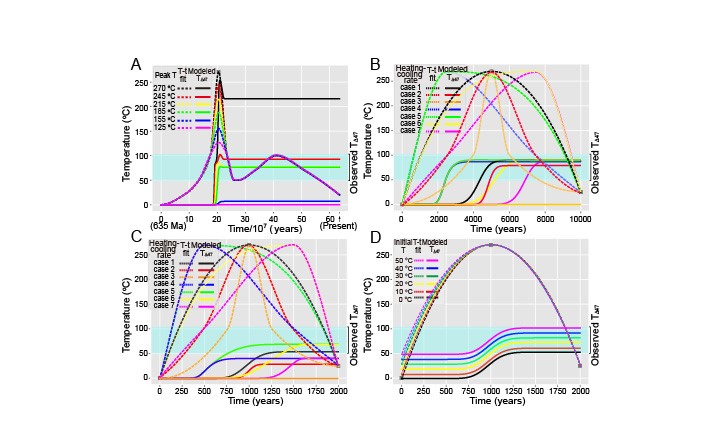Abstract
Paleozoic and Precambrian sedimentary successions frequently contain massive dolomicrite [CaMg(CO3)2] units despite kinetic inhibitions to nucleation and precipitation of dolomite at Earth surface temperatures (<60 °C). This paradoxical observation is known as the “dolomite problem.” Accordingly, the genesis of these dolostones is usually attributed to burial–hydrothermal dolomitization of primary limestones (CaCO3) at temperatures of >100 °C, thus raising doubt about the validity of these deposits as archives of Earth surface environments. We present a high-resolution, >63-My-long clumped-isotope temperature (TΔ47) record of shallow-marine dolomicrites from two drillcores of the Ediacaran (635 to 541 Ma) Doushantuo Formation in South China. Our T∆47 record indicates that a majority (87%) of these dolostones formed at temperatures of <100 °C. When considering the regional thermal history, modeling of the influence of solid-state reordering on our TΔ47 record further suggests that most of the studied dolostones formed at temperatures of <60 °C, providing direct evidence of a low-temperature origin of these dolostones. Furthermore, calculated δ18O values of diagenetic fluids, rare earth element plus yttrium compositions, and petrographic observations of these dolostones are consistent with an early diagenetic origin in a rock-buffered environment. We thus propose that a precursor precipitate from seawater was subsequently dolomitized during early diagenesis in a near-surface setting to produce the large volume of dolostones in the Doushantuo Formation. Our findings suggest that the preponderance of dolomite in Paleozoic and Precambrian deposits likely reflects oceanic conditions specific to those eras and that dolostones can be faithful recorders of environmental conditions in the early oceans.

Figure 1: Clumped-isotope–based paleotemperature (TΔ47) profile of the Ediacaran Doushantuo Formation dolomites, with paired petrological and geochemical data for evaluation of dolomitic recrystallization, diagenesis, and solid-state reordering, from drillcores ZK407 and ZK312-P312 in Zhangcunping area, Hubei Province, South China. (A) Size distributions of dolomite grains. (B) Dolomite concentrations. (C) Mn/Sr ratios; values <3 indicate insignificant diagenetic alteration (26). (D) Oxygen isotopic compositions of dolomite (δ18Odol; parts per thousand relative to Vienna Pee Dee Belemnite [VPDB]). (E) Peak heating temperatures (T) derived from Raman spectra and equivalent vitrinite reflectance (eq-Ro) measurements of coexisting OM. The dashed line at 270 °C is the rough average of two peak heating temperature records. (F) TΔ47 records, demonstrating low dolomite-formation temperatures (<100 °C for directly measured TΔ47 values and <60 °C for modeled values of solid-state reordering effects give an average peak heating temperature of 270 °C for 2,000 y). The data uncertainties are given as SD (σ) for grain size and peak heating temperature or SE (s.e.) for TΔ47. Dolomite grain size and peak heating temperatures were measured from thin sections, and other data were generated using microdrilled powders. See Methods and SI Appendix for details. Data sources: lithostratigraphic data for ZK312-P312 are from ref. 22; geochronological data are from refs. 20 and 21. Abbreviations: Fm., Formation; Mb., Member.

Figure 2: Solid-state reordering modeling of the study Doushantuo Formation. (A) Model results for long-duration (∼107 y) hydrothermal events. These models assumed an initial temperature of 0 °C and peak temperatures of 125, 155, 185, 215, 245, and 270 °C with symmetric heating–cooling rates over a 6 × 107-y interval beginning at 460 Ma. The models were based on the reconstructed thermal history of Fig. 3 from 635 Ma to the present. (B and C) Model results for short-duration (B: ×104 y; C: ×103 y) hydrothermal events. These models assumed an initial temperature of 0 °C, a peak heating temperature of 270 °C for 10,000 y (in B) or 2,000 y (in C) with variable heating–cooling rates, including three symmetric heating–cooling cases (cases 1 to 3) and four asymmetric heating–cooling cases (cases 4 to 7). (D) Model results assuming a varying initial temperature from 0 to 50 °C, a peak temperature of 270 °C for 2,000 y, and a fixed heating–cooling rate (i.e., case 1 in C). In all subfigures, the “T-t fit” lines denote assumed heating T-time paths, while the “Modeled T∆47” lines denote the corresponding T∆47 evolution of the Doushantuo dolomites predicted by a solid-state reordering model. The shallow blue bands represent the range of measured T∆47 values of well-preserved Doushantuo dolomites in this study. See Results and Discussion for further details.
Title: Massiveformation of early diagenetic dolomite in the Ediacaran ocean: Constraints onthe “dolomite problem”
Authors: Biao Chang, Chao Li*, Deng Liu, Ian Foster, Aradhna Tripati, Max K.Lloyd, Ingrid Maradiaga, Genming Luo, Zhihui An, Zhenbing She, Shucheng Xie,Jinnan Tong, Junhua Huang*, Thomas J. Algeo, Timothy W. Lyons, and AdrianImmenhause
Doi: 10.1073/pnas.1916673117
Published: June 8, 2020
Link to the paper: https://doi.org/10.1073/pnas.1916673117